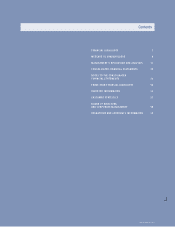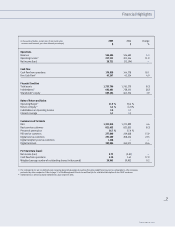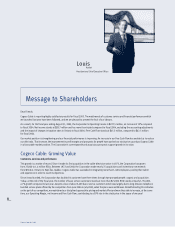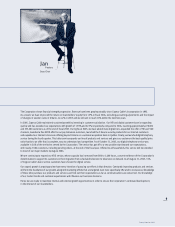Cogeco 2005 Annual Report Download - page 15
Download and view the complete annual report
Please find page 15 of the 2005 Cogeco annual report below. You can navigate through the pages in the report by either clicking on the pages listed below, or by using the keyword search tool below to find specific information within the annual report.
Management’s Discussion and Analysis
Cogeco Cable Inc. 2005
13
Cable Networks
Digital and VOD services are available to 98% and 87% of households,
respectively, and 89% of households passed are served by
a two-way cable plant. Cogeco Cable’s fiber optic network extends
over 8,100 kilometres and includes 79,200 kilometres of optical
fiber. Cogeco Cable has deployed optical fiber to nodes serving
clusters of typically 1,500 households, with many fibers per node
in most cases, which allows the Corporation to further extend
the fiber plant to smaller clusters of 500 households rapidly
with relative ease. Node splitting leads to further improvement
in the quality and reliability of services and allows for increasing
traffic of two-way services such as HSI and VOD.
Cogeco Cable is still using the DOCSIS 1.1 standard (Data Over Cable
Service Interface Specifications) for its IP platform. DOCSIS 1.1
allows the prioritization of the signal packets that must be
transmitted in real time, such as those of digital telephony service,
so as to ensure a continuous transmission flow. When appropriate,
the DOCSIS 2.0 transmission mode can be activated to increase
the speed and capacity of the return path, thus making it possible
to provide very high speed symmetrical services, which are
particularly well suited for commercial customer applications.
It is also more robust, allowing for the use of portions of the return
path spectrum that are normally not useable in a DOCSIS 1.1 mode.
In addition, the cable industry, in collaboration with CableLabs,
is in the process of developing a new standard, DOCSIS 3.0,
compatible with the earlier versions and will make it possible
to increase IP transmission speeds even more, up to 200 Mbps.
Key Performance Indicators
Cogeco Cable is dedicated to increasing shareholder value and
consequently focuses on optimizing profitability while efficiently
managing its use of capital without jeopardizing future growth.
The following key performance indicators are closely monitored
to ensure that business strategies and objectives are closely aligned
with shareholder value creation. The key performance indicators
are not measurements in accordance with Canadian GAAP and should
not be considered an alternative to other measures of performance
in accordance with GAAP. The Corporation’s method of calculating
key performance indicators may differ from other companies and,
accordingly, these key performance indicators may not be comparable
to similar measures presented by other companies.
Income Before Income Taxes
Per Home Passed and Return on Equity
Income before income taxes per home passed provides key insights
on how Cogeco Cable maximizes the value of its franchises.
Excluding income taxes from the profitability measure removes
an often volatile and non-controllable factor. The “per home passed”
concept measures Cogeco Cable’s effectiveness in improving
profitability in its franchised areas.
Return on Equity is defined as net income or loss divided by average
shareholders’ equity (computed on the basis of the beginning
and ending balance for a given fiscal year). Return on Equity
measures the Corporation’s effectiveness in generating net income
on a given capital base from our shareholders. Cogeco Cable’s key
goal in the coming years is to achieve a return on equity of 10%.
Operating Income Growth and Operating Margin
Operating Income is calculated as operating income before
amortization and unusual items that are non-recurring revenue
or expense items such as restructuring charges and gains
or losses on asset disposals. Operating Margin is calculated
by dividing Operating Income with revenue. Operating Income
growth and Operating Margin are benchmarks commonly used
in the telecommunications industry, as they allow comparisons
with companies that have different capital structures and are
more current measures since they exclude the impact of historical
investments in assets. Operating Income indicators assess
Cogeco Cable’s ability to seize growth opportunities in a cost
effective manner, to finance its ongoing operations, and to service
its debt. Operating Income is a proxy for cash flow generated
from operations excluding the impact of the capital structure
chosen. Consequently, Operating Income is one of the key
metrics used by the financial community to value the business
and its financial strength.
Free Cash Flow
Free Cash Flow is defined as cash flow from operations less capital
expenditures (including assets acquired under capital lease
that are disclosed in Note 12b) on page 50 which are not reflected
in the statements of cash flow) and increase in deferred charges.
The financial community also closely follows this indicator since
it measures the business’ ability to repay debt, distribute capital
to its shareholders and finance its growth.
RGU Growth and Penetration of Service Offerings
RGU expansion is a critical driver of revenue growth and measures
the success of the marketing strategy and the competitiveness
of the service offering and pricing. Penetration statistics measure
Cogeco Cable’s market share. Cogeco Cable computes the
penetration for basic services as a percentage of homes passed
and, in the case of all other services, as a percentage of basic
customers in the cable systems where the service is offered.
Customer Churn
Customer churn provides a key measure of customer satisfaction
and the effectiveness of loyalty programs. A retention focus
is more cost-effective than ongoing heavy acquisition efforts
with low retention success.
Productivity Indicators
Operating expenses per RGU is a prime measure of productivity
as RGU is the key driver of revenue growth. Cogeco Cable strives to
achieve strong RGU growth while closely monitoring its cost structure.
























